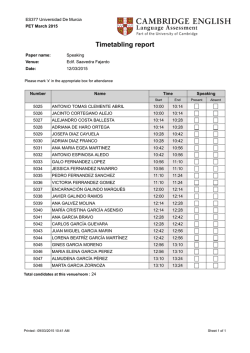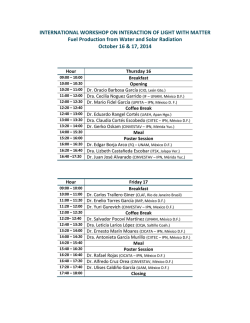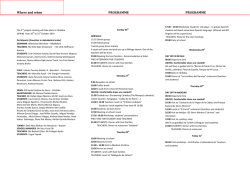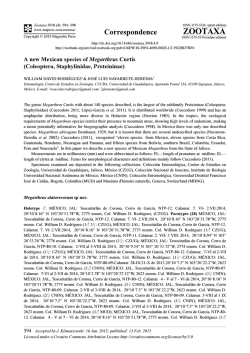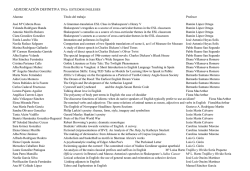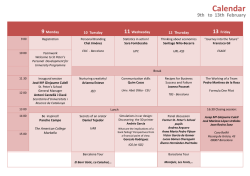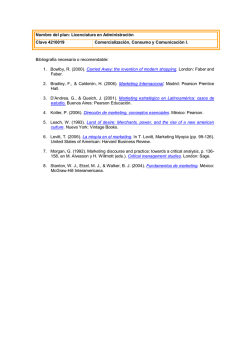
Dugesiana, Año 22, No. 2, Julio
Dugesiana, Año 22, No. 2, Julio-Diciembre 2015, es una publicación Semestral, editada por la Universidad de Guadalajara, a través del Centro de Estudios en Zoología, por el Centro Universitario de Ciencias Biológicas y Agropecuarias. Camino Ramón Padilla Sánchez # 2100, Nextipac, Zapopan, Jalisco, Tel. 37771150 ext. 33218, http://dugesiana.cucba.udg.mx, [email protected]. Editor responsable: José Luis Navarrete Heredia. Reserva de Derechos al Uso Exclusivo 04-2009-062310115100-203, ISSN: 2007-9133, otorgados por el Instituto Nacional del Derecho de Autor. Responsable de la última actualización de este número: Coordinación de Tecnologías para el Aprendizaje, Unidad Multimedia Instruccional, M.B.A. Oscar Carbajal Mariscal y José Luis Navarrete Heredia. Fecha de la última modificación 14 de diciembre 2015, con un tiraje de un ejemplar. Las opiniones expresadas por los autores no necesariamente reflejan la postura del editor de la publicación. Queda estrictamente prohibida la reproducción total o parcial de los contenidos e imágenes de la publicación sin previa autorización de la Universidad de Guadalajara. Dugesiana 22(2): 153-162 Fecha de publicación: 14 de diciembre 2015 ©Universidad de Guadalajara ISSN 1405-4094 (edición impresa) ISSN 2007-9133 (edición online) Five new species of Mexican Lachesilla (Psocodea: Psocomorpha: Lachesillidae), in species group Corona Cinco nuevas especies de Lachesilla mexicanas (Psocodea: Psocomorpha: Lachesillidae) en el grupo de especies Corona Alfonso N. García Aldrete Departamento de Zoología, Instituto de Biología, Universidad Nacional Autónoma de México, Apartado Postal 70-153, 04510, México, D. F. MÉXICO. E-mail: [email protected] ABSTRACT Five Mexican species of Lachesilla in species group Corona are here described and illustrated. The types are deposited in the National Insect Collection, Instituto de Biología, Universidad Nacional Autónoma de México (CNIN), in México City. Key words: Taxonomy, Nearctic, Neotropics, ‘Psocoptera’. RESUMEN Se describen e ilustran cinco nuevas especies mexicanas de Lachesilla, del grupo de especies Corona. Los tipos están depositados en la Colección Nacional de Insectos (CNIN), en el Instituto de Biología, Universidad Nacional Autónoma de México, en México, D. F. Palabras clave: Taxonomía, Neártico, Neotrópico, ‘Psocoptera’. The females of the species of Lachesilla in species group Corona, are characterized mostly by having a mesal flap or a projection on the subgenital plate; occasionally, the subgenital plate is projected posteriorly in the middle. The males of the species in this group have the hypandrium projected posteriorly on each side, with a concavity in between. The phallosome apodemes are generally V shaped, the epiproct is generally distinctly bilobed, and the paraprocts have a mesal sclerotized prong. For more diagnostic details of this species group, see García Aldrete (1974), and Mockford (1993). Species group Corona is very species rich with 24 described species and 52 undescribed species deposited in the National Insect Collection. Figure 19 shows the distribution of species of this group in the Americas: two species each in Canada (L. albertina García Aldrete, and L. corona Chapman) and the US (Lachesilla corona Chapman, and L. michiliensis García Aldrete), 68 species in Mexico, 46 undescribed; 14 species in Central America, 13 undescribed; 5 species in Colombia, 3 undescribed, 2 species in Ecuador (L. lingua New & Thornton and L. picticepsoides García Aldrete), and 1 species in Brazil (L. breviforceps García Aldrete). In this paper, I describe 5 species of Lachesilla in this group, selected at random from the 46 undescribed species ocurring in Mexico. The types are deposited in the National Insect Collection (CNIN, acronym of Colección Nacional de Insectos), Instituto de Biología, Universidad Nacional Autónoma de México. MATERIAL AND METHODS Five specimens were studied, each representing one species. To record color, the whole specimens, before dissection, were placed in 80% ethanol under a stereoscopic microscope illuminated with cold white light at 50X. The specimens were dissected in 80% ethanol, and their parts (head, right wings and legs, and genitals), were mounted on slides in Canada balsam, following standard procedures. The illustrations were made utilizing a drawing tube; parts on the slides were measured utilizing a filar micrometer, with a measuring unit of 1.36 mm for wings, and 0.53 mm for other parts. Abbreviations of parts measured are as follows: FW and HW: right fore- and hind- wing lengths, F, T, t1 and t2: lengths of femur, tibia, and tarsomeres 1 and 2 of right hind leg, ctt1: number of ctenidia on t1, Mx4: length of fourth segment of right maxillary palp, f1…fn: length of antennal flagellomeres 1…n of right antenna, IO, D and d: respectively, minimum distance between compound eyes, antero-posterior diameter, and transverse diameter of right compound eye, all in dorsal view of head mounted on the slide, PO: d/D. RESULTS Lachesilla gomezfariasensis n. sp. Female (Figs 1-4) Color (in 80% ethanol). Body pale brown. Compound eyes black, ocelli hyaline, without pigmented centripetal crescents. Maxillary palps brown. Wings hyaline, with a faint orange hue. An ochre spot on upper part of propleura, behind compound eyes. A slender ochre band on thoracic pleura, above the level of the coxae. Abdomen whitish, with ochre subcuticular rings, faded ventrally. Stigmasac and R1 ochre, veins pale brown. Morphology. Upper ends of compound eyes not Dugesiana reaching the level of the vertex. Forewing Rs-M fused for a short length. Pterostigma elongate, wider posteriorly. Areola postica broadly triangular, apex rounded, slightly slanted posteriorly (Fig. 1). Subgenital plate (Fig. 2) broad, setose as illustrated, rounded posteriorly, distal third glabrous; mesal flap triangular, minuscule, anteriorly concave. Gonapophyses (Fig. 3) proximally wide, narrowing posteriorly to a blunt apex; a sclerotized slender band along outer border and proximal end, with an apophysis extended from outer border; setal field on surface, as illustrated. Ninth sternum (Fig. 3) almost rectangular, pigmented on anterior half, with antero-lateral corners rounded, slightly protuberant. Spermapore posteriorly, small, with a pigmented rim. Paraprocts (Fig. 4) semi-elliptic, setose, sensory fields with 9-10 trichobothria on basal rosettes, and one marginal trichobothrium without basal rosette. Epiproct trapeziform, with field of setae on distal half. Measurements (in mm). FW: 1725, HW: 1360, F: 371, T: 711, t1: 256, t2: 93, ctt1: 16, f1: 210, f2: 195, Mx4: 97, IO: 281, D: 159, d: 106, IO/d: 2.65, PO: 0.66. Type locality. MEXICO. Tamaulipas. 8 km W Gómez Farías, 15 June, 1962. Beating vegetation, E. L. Mockford. Holotype female. CNIN. Etymology. The specific epithet refers to the type locality, Gómez Farías, Tamaulipas, where the only specimen of this species was found. Lachesilla jacalaensis n. sp. Female (Figs 5-8) Color (in 80% ethanol). Body tawny brown. Compound eyes black, ocelli hyaline, without pigmented centripetal crescents. Mx4 dark brown, more pigmented than Mx 1-3. Wings hyaline, veins pale brown. Abdomen whitish, with pale brown subcuticular rings, less pigmented ventrally. Morphology. Forewing Rs-M fused for a short distance. Pterostigma elongate, rounded and wider distally. Areola postica wide, triangular, apically rounded (Fig. 5). A vein stub proximally on Rs (not shown in the figure). Subgenital plate (Fig. 7) broad, setose, projected posteriorly in the middle, distal third glabrous. Mesal flap long, slender, with sides parallel, distally blunt. Gonapophyses (Fig. 6), with sides almost parallel, with sclerotized band proximally on outer border and along proximal end, and with a small rounded projection distally, extended from outer border; setal field on surface, with about 16 setae. Ninth sternum (Fig. 6) broad, anteriorly straight, with a distinct, narrow, pigmented band anteriorly; distal two thirds unpigmented; spermapore in the center of the sclerite, small, with a pigmented rim. Paraprocts (Fig. 8) almost elliptic, setae as illustrated, sensory fields with 11 trichobothria on basal rosettes, and one marginal trichobothrium without basal rosette. Epiproct (Fig. 8) almost trapeziform, with setal field on distal third, along sides and posterior border. Measurements (in mm). FW: 2357, HW: 1890, F: 365, T: 784, t1: 212, t2: 85, ctt1: 16, f1: 222, f2: 176, f3: 139, f4: 111, Mx4: 97, IO: 347, D: 172, d: 93, IO/d: 3.73, PO: 0.54. 154 Type locality. MEXICO. Hidalgo. 32 km N Jacala, Hwy. 85. 16 April, 1964. Beating Liquidambar sp. E. L. Mockford. Holotype female. CNIN. Etymology. The specific epithet refers to the type locality, Jacala, Hidalgo, where the only specimen of this species was found. Lachesilla lacustrina n. sp. Male. (Figs 9-11) Color (in 80% ethanol). Body pale brown. Compound eyes black, ocelli hyaline, without pigmented centripetal crescents. Maxillary palps, antennae and legs pale brown. Thoracic pleura uniformly pale brown. Wings almost hyaline, slightly opaque, veins brown. Morphology. Forewing (Fig. 9), with Rs-M fused for a short distance. Pterostigma elongate, wider distally. Areola postica triangular, with apex rounded (Fig. 9). Hypandrium (Fig. 10) broad, setose, with a field of short, strong spines on each side of the median concavity. Posterior processes robust, wide based, narrowing distally to rounded end, which bears a small, rounded protuberance. Phallosome apodemes (Fig. 10), closed anteriorly, each arm proximally slender, distally broad, acuminate, with a row of short spines distally along outer border. Paraprocts (Fig. 11) broad, rounded, with mesal prong curved, distally truncate; sensory fields with 12 trichobothria on basal rosettes, and one marginal trichobothrium without basal rosette. Epiproct (Fig. 11) broadly trapeziform, bilobed, each lobe bearing a setal field on side and posterior border. Measurements (in mm). FW: 2144, HW: 1609, F: 394, T: 759, t1: 220, t2: 102, ctt1: 16, f1: 254, f2: 216, f3: 196, f4: 166, Mx4: 102, IO: 336, D: 163, d: 98, IO/d: 3.42, PO: 0.6. Type locality. MEXICO. Chiapas. Lagunas de Montebello, 60 km SE Comitán, 1580m. 11 August, 1975. Beating vegetation, A. N. García Aldrete. Holotype male. CNIN. Etymology. The specific epithet refers to the lacustrine nature of the type locality. Lachesilla moroni n. sp. Male. (Figs 12-14) Color (in 80% ethanol). Body reddish brown, compound eyes black, ocelli hyaline, without pigmented centripetal crescents. Maxillary palps brown. Wings almost hyaline, with a pale orange hue, veins pale brown, forewing R1 bordering pterostigma ochre. Abdomen whitish, with ochre, transverse, subcuticular rings, faded ventrally. Morphology. Forewing pterostigma elongate, wider distally; Rs-M meeting at a point, areola postica wide, broadly triangular (Fig. 12). Hypandrium (Fig. 13) wide, with a setal field on each side; posterior processes narrowing distally, slightly pointed at apex; phallosome apodemes (Fig. 13) V shaped, each arm proximally slender, distal half dilated, acuminate, with a short row of spines on inner border, anteapically. Paraprocts (Fig. 14), Five new species of Mexican Lachesilla (Psocodea: Psocomorpha: Lachesillidae), in species group Corona robust, mesal prong curved, distally pointed, sensory fields with 11 trichobothria on basal rosettes, and one marginal trichobothrium (not figured), without basal rosette. Epiproct (Fig. 14) broad, bilobed, each lobe with a setal field along sides and posterior margin. Measurements (in mm). FW: 1908, HW: 1434, F: 376, T: 700, t1: 219, t2: 94, ctt1: 15, f1: 216, f2: 177, f3: 159, f4: 130, Mx4: 94, IO: 317, D: 166, d: 89, IO/d: 3.56, PO: 0.54. Type locality. MEXICO. Puebla. La Unión, ca. Xicotepec de Juárez, 1,000 m. 16 0ctober, 1982, beating dead, hanging banana fronds in coffee plantation, A. N. García Aldrete. Holotype male. CNIN. Etymology. This species honors the Mexican coleopterist Miguel Ángel Morón Ríos, of the Instituto de Ecología, A. C., in Xalapa, Veracruz, in recognition to his many and important contributions to the taxonomy of Scarabeoidea. Lachesilla omitlanensis n. sp. Female (Figs 15-18) Color (in 80 % ethanol). Body tawny brown. Compound eyes black, ocelli hyaline, without pigmented centripetal crescents. Mx4 dark brown, Mx 1-3 pale brown. Wings hyaline, veins pale brown. Abdomen whitish, with pale brown subcuticular rings, faded ventrally. Morphology. Forewing (Fig. 15), pterostigma long, wider posteriorly, Rs-M meeting at a point, areola postica broadly triangular. Subgenital plate (Fig. 17) broad, setose as illustrated, mesal flap large, club shaped. Gonapophyses (Fig. 16) with sides almost parallel, outer border proximally with a short pigmented band, slightly extended anteriorly, distal end with a short protuberance, extended from the outer border, setal field on surface, as illustrated. Ninth sternum (Fig. 16) wide, with pigmented area enclosing the spermapore, this small, located posteriorly, surrounded by a pigmented rim. Paraprocts (Fig. 17), robust, setose, sensory fields with 11 trichobothria on basal rosettes, and one marginal trichobothrium without basal rosette. Measurements (in mm). FW: 1983, HW: 1501, F: 329, T: 648, t1: 186, t2: 91, ctt1: 14, f1: 174, f2: 145, f3: 126, f4: 105, Mx4: 96, IO: 367, D: 155, d: 86, IO/d: 4.26, PO: 0.55 Type locality. MEXICO. Hidalgo. Omitlán, ca. Real del Monte. 21 August, 1980, beating branches of Quercus sp. A. N. García Aldrete. Holotype female. CNIN. Etymology. The specific epithet refers to the type locality of this species. REMARKS It is risky to describe a new taxon on basis of one specimen, particularly in groups where most of the species are sexual, as in the case of Lachesilla, but it is not always possible to have reliable male-female associations, and then one has to depend on detailed morphological comparisons, to maintain at a minimum the possibility of creating eventual synonymies. In Lachesilla, the interspecific differences are in general quite large in both sexes, resulting in entities distinct morphologically, but one has to run the risk that one species described from one male and one species described from one female may eventually prove to be the same species. Table 1 shows the described Mexican species of Lachesilla in species group Corona, and the distribution of each; they have been collected in 19 of the 32 Mexican states (including the Federal District), with some states being richer than others, e. g., Hidalgo (11 species), Puebla (eight species), Oaxaca (seven species), Veracruz (six species), and on the other hand, several states with only one species, which could well be a collecting bias. Since 41 Mexican species in the group remain undescribed, it is quite premature at this time to attempt to write an identification key to the Mexican species in the group. Lachesilla gomezfariasensis belongs in an assemblage of related species that includes L. dispariforceps Mockford, L. dividiforceps García Aldrete, L. lingua New & Thornton, L. picticeps Mockford, and L. picticepsoides García Aldrete. It shares with the latter having somewhat similar gonapophyses, and having the flap of the subgenital plate triangular; the two species differ in that, in the former, the flap of the subgenital plate is very small, and the gonapophyses are longer and more pointed than in the latter. Lachesilla jacalaensis seems related to L. hermosa García Aldrete, in having the subgenital plate posteriorly projected in the middle, in having an elongate mesal projection on the subgenital plate, and in having the gonapophyses with sides almost parallel, with a small apical projection. Lachesilla omitlanensis is unique among the species of Lachesilla in the Corona species group, in having the flap of the subgenital plate proximally narrow and widely dilated and rounded posteriorly, very different from the other species in the group. The hypandrium and phallosome in L. lacustrina and L. moroni are built on the same general plan as in other species in the group; they difer in details of these structures, mostly on the hypandrium processes. Both species have stout hypandrium processes, in the former the processes are more robust, with a small apical protuberance, and there is a field of stout spines next to each border of the concavity, absent in the latter. In L. moroni the phallosome apodemes are more V shaped, with the arms posteriorly directed, not crossed and directed outwards as in L. lacustrina. ACKNOWLEDGMENTS I thank Alberto Moreira da Silva Neto for the map of species distribution, and Alyne Pérez, for support with the illustrations of the species here treated. I also thank Instituto de Biología, Universidad Nacional Autónoma de México, for continuous research support. 155 Dugesiana LITERATURE CITED García Aldrete, A. N. 1973. A new species of Lachesilla (Insecta: Psocoptera) from Northeast Mexico. Anales del Instituto de Biología, Universidad Nacional Autónoma de México 44, Ser. Zoología (1): 55-60. García Aldrete, A. N. 1974a. A classification above species level of the genus Lachesilla Westwood (Psocoptera: Lachesillidae). Folia Entomológica Mexicana (27): 1-88. García Aldrete, A. N. 1974b. Lachesilla curviforceps sp. nov., un nuevo psocóptero de México (Psocoptera: Lachesillidae). Anales del Instituto de Biología, Universidad Nacional Autónoma de México 45, Ser. Zoología (1): 65-70. García Aldrete, A. N. 1974c. Lachesilla dividiforcepes n. sp., un nuevo psocóptero mexicano (Psocoptera: Lachesillidae). Publicaciones Biológicas. Instituto de Investigaciones Científicas. U.A.N.L. 1 (6): 79-85. García Aldrete, A. N. 1974d. Una nueva especie de Lachesilla (Psocoptera: Lachesillidae), en el grupo Corona. Folia Entomológica Mexicana (28): 37-42. García Aldrete, A. N. 1982. Descriptions of new Lachesilla species and description of the female L. magnifica García Aldrete (Psocoptera, Lachesillidae) Folia Entomológica Mexicana (53): 43-65. Mockford, E. L. 1986. A key to species of psocids of the Lachesilla corona group (Psocoptera: Lachesillidae) in Eastern Mexico, with descriptions of two new species. Entomological News 97(4): 133-140. Mockford, E. L. 1993. North American Psocoptera (Insecta). Flora and Fauna Handbook 10. Sandhill Crane Press, Gainesville, Florida. Recibido: 22 de junio 2015 Aceptado: 16 de septiembre 2015 Table 1. Species of described Mexican Lachesilla in species group Corona and distribution L. chamula García Aldrete, 1982, p. 51. Chiapas. L. contrerasi García Aldrete, 2015, p. 10. Hidalgo. L. curviforceps García Aldrete, 1974 a, p. 65. Puebla, San Luis Potosí, Tamaulipas, Veracruz. L. dispariforceps Mockford, 1986, p. 136. Hidalgo, México, Oaxaca, Puebla, Veracruz, GUATEMALA. L. dividiforceps García Aldrete, 1974 b, p. 80. Coahuila, Hidalgo, Nuevo León, Puebla, Querétaro, Tamaulipas,, Veracruz. L. gomezfariasensis n. sp.Tamaulipas. L. hermosa García Aldrete, 1982, p. 53. Chiapas, Hidalgo, Jalisco, Nuevo León, Oaxaca, Puebla, Veracruz. L. ixtlanensis García Aldrete & Casasola, 2012, p. 137. Oaxaca. L. jacalaensis n. sp.Hidalgo. L. lachataoensis García Aldrete & Casasola, 2012,p. 137. Oaxaca. L. lacustrina n. sp. Chiapas. L. michiliensis García Aldrete, 1991, p. 168. Durango. USA, Texas. L. moroni n. sp.Puebla. L. neoleonensis García Aldrete, 1974 c, p. 40. Nuevo León. L. omitlanensis n. sp.Hidalgo. L. picticeps Mockford, 1986, p. 134. Chiapas, Distrito Federal, Guanajuato, Guerrero, Hidalgo, México, Nuevo León, Puebla, Querétaro. L. picticepsoides García Aldrete, 1997, p. 216. Puebla. COLOMBIA. ECUADOR. L. querpina García Aldrete, 1991, p. 171. Chihuahua, Durango, Guerrero, Hidalgo, Morelos, Nuevo León, Oaxaca. L. regiomontana García Aldrete, 1973, p. 55. Nuevo León. L. reyesi García Aldrete, 1991, p. 174. Durango, Hidalgo, México, Michoacán. L. silvatica García Aldrete, 1988, p. 53. Jalisco, Veracruz. L. tuita García Aldrete, 1988, p. 56. Jalisco. L. unsijensis García Aldrete & Casasola, 2012, p.136. Oaxaca. L. zuninoi García Aldrete, 2014, p. 151. Hidalgo, Veracruz. L. zuninoides García Aldrete, 2014, p. 152. Guerrero, Hidalgo, Michoacán, Oaxaca. 156 Five new species of Mexican Lachesilla (Psocodea: Psocomorpha: Lachesillidae), in species group Corona Figures 1-4. Lachesilla gomezfariasensis n. sp. Female. 1. Fore- and hind- wings. 2. Subgenital plate. 3. Gonapophyses and ninth sternum. 4. Epiproct and right paraproct. Scales in mm. 157 Dugesiana Figures 5-8. Lachesilla jacalaensis n. sp. Female. 5. Fore- and hind- wings. 6. Gonapophyses and ninth sternum. 7. Subgenital plate. 8. Epiproct and left paraproct. Scales in mm. 158 Five new species of Mexican Lachesilla (Psocodea: Psocomorpha: Lachesillidae), in species group Corona Figures 9-11. Lachesilla lacustrina n. sp. Male. 9. Fore- and hind- wings. 10. Hypandrium and phallosome apodemes. 11. Epiproct and left paraproct. Scales in mm. 159 Dugesiana Figures 12-14. Lachesilla moroni n. sp. Male. 12. Fore- and hind- wings. 13. Hypandrium and phallosome apodemes. 14. Epiproct and left paraproct. Scales in mm. 160 Five new species of Mexican Lachesilla (Psocodea: Psocomorpha: Lachesillidae), in species group Corona Figures 15-18. Lachesilla omitlanensis n. sp. Female. 15. Fore- and hind- wings. 16. Gonapophyses and ninth sternum. 17. Subgenital plate. 18. Epiproct and right paraproct. Scales in mm. 161 Dugesiana Figure 19. Distribution of species of Lachesilla in species group Corona in the Americas. 162
© Copyright 2025
